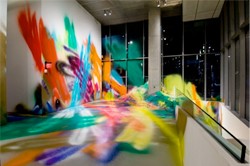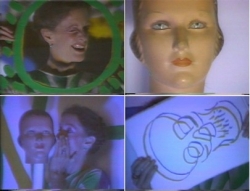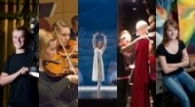Fiction and Legacy

Katharina Grosse, Cincy, 2006: acrylic on wall, floor, glass, styrofoam and soil, installation at the Contemporary Arts Center in Cincinnati (photo courtesy of the artist)
Radford University Department of Art is hosting an advance screening of two episodes, "Fiction and Legacy," from season seven of Art21’s Peabody Award-winning documentary series "Art in the Twenty-first Century." This screening is on Oct. 1 at 5:30 p.m. at the Bonnie Hurlburt Student Center.
ART21 Access ’14 is an international free screening initiative created to increase knowledge of contemporary art, spark dialogue, and inspire creative thinking through hundreds of public screenings and events. Season seven premieres on PBS Oct.24 at 10 p.m. EST (check local listings). Season seven profiles twelve artists who reveal how art can inspire and transform lives and communities.

Joan Jonas, Upsidedown and Backwards, video stills, 1980; video, color, sound (image courtesy of the artist)
ART21 Access ’14 events are presented in partnership with Americans for the Arts, the YMCA, and the National Alliance for Media Arts and Culture. An updated list of ART21 Access ’14 events and venues worldwide can be found at art21.org/access.
This prescreening event will give audience members an opportunity to experience this provocative, informative and innovative series before it airs on tv. Join the department for this opportunity to experience exciting and unusual contemporary art, to discuss it with peers and colleagues, and to participate in a Creative Arts Week event.
About Episode 3: Legacy
Why do people break with some traditions and perpetuate others? Artists in this episode use life experiences and family heritage to explore new aesthetic terrain.
Inspired by the teachings of Laotzi, by the modern artist Brancusi, and by formative experiences with his family in Germany and India, Wolfgang Laib’s sculptures seem to connect the past and present, the ephemeral and eternal. His attention to human scale, duration of time, and his choice of materials give his works the power to transport us to unexpected realms of memory, sensory pleasure, and contemplation.
Tania Bruguera explores the relationship between art, activism, and social change, staging participatory events and interactions that build on her own observations, experiences, and understanding of the politics of repression and control. Her work advances the concept of arte útil, according to which art can be used as a tool for social and political empowerment.
Abraham Cruzvillegas works in his Mexico City studio and at exhibitions in Paris and Minneapolis to assemble sculptures and installations from found objects and disparate materials, through which he explores the effects of improvisation, transformation, and decay. His experiments with video, performance, family archives, and academic research reveal the deep connection between his identity, born of the harsh realities of his family’s life in Mexico, and his artistic practice.
About Episode 4: Fiction
What makes a compelling story? How do artists disrupt everyday reality in the service of revealing subtler truths? This episode features artists who explore the virtues of ambiguity, mix genres, and merge aesthetic disciplines to discern not simply what stories mean, but how and why they come to have meaning.
Katharina Grosse creates wildly colorful sculptural environments and paintings that unite the fluid perception of landscape with the ordered hierarchy of painting. Her work is a material record—a story—and, perhaps, an inscription of her thoughts, or an illusion. Grosse uses boat building techniques to create monumental abstract sculptures for display at Brooklyn’s Metrotech Plaza, while at the Nasher Sculpture Center in Dallas, she adds layers of paint to a room filled with soil as a painted sculpture pierces through the building’s architecture. Shown at work in her Berlin studio, Grosse leads viewers through the recent project "I Think This Is a Pine Tree at the Hamburger Bahnhof."
In Sweden, pioneering artist Joan Jonas performs at both Umeå Jazzfestival with musician Jason Moran, and at Kulturhuset in Stockholm, where she reconfigures her 1969 performance Mirror Piece. Working in performance, video, installation, sculpture, and drawing, Jonas finds inspiration in mythic stories, investing texts from the past with the politics of the present. Wearing masks and drawing while performing on stage, Jonas disrupts the conventions of theatrical storytelling to emphasize potent symbols and critical self-awareness.
In multi-channel video installations, Omer Fast blurs the boundaries between documentary, dramatization, and fantasy, frequently generating viewers’ confusion. Fast plays with our assumptions about identity and the structure of dramatic narrative, revealing shades of meaning as stories are told, retold, and mythologized.
Press release courtesy ART21
